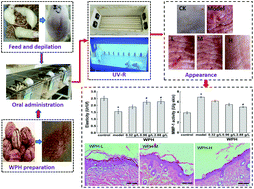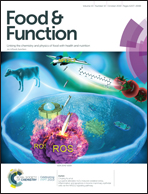Regulation by walnut protein hydrolysate on the components and structural degradation of photoaged skin in SD rats
Abstract
Skin photoaging induced by consecutive exposure of skin to ultraviolet radiation is primarily responsible for skin aging and preparation of food-derived ingredients with anti-aging functions has been the hot topic worldwide. Dietary consumption of food supplements has been found to modulate skin functions and can be useful in the prevention of skin aging. To evaluate the effect of walnut protein hydrolysate (WPH) on photoaged skin, Sprague-Dawley rats (SD rats) were orally administered with WPH and then were regularly exposed to ultraviolet radiation (UV-R). After a consecutive UV-R for 18 weeks, the delaying efficiency of WPH against elasticity degradation was examined and the mechanical mechanism was explored subsequently. The contents of hydroxyproline (Hyp) and hyaluronic acid (HA) in the extracellular matrix (ECM) were measured by biochemical reactions and color rendering procedures; the levels of types I and III collagen (Col I and III) and the activity of matrix metalloproteinase-1 (MMP-1) were detected by enzyme-linked immunosorbent assay (ELISA); the protein levels of elastin and fibrillin-1 were examined by western blotting. Moreover, the histological change in the skin structure was illustrated by hematoxylin & eosin (HE) and Masson staining. The results revealed that WPH evidently enhanced the elasticity of photoaged skin and stimulated the biosynthesis of ECM components Col I, Hyp and HA in the dermal layer; meanwhile WPH inhibited the MMP-1 activity, alleviated epidermal hyperplasia, and repaired the damaged skin mechanical structure in a dose-dependent manner. In particular, in comparison with the UV-R group, the WPH group in which WPH was administered at a high-dose level showed significantly improved skin appearance, ECM components and structure (P < 0.05). Taken together, the elasticity improvement caused by WPH against the skin photoaging process can be attributed to the regulation of the metabolism of the components and repair of the damaged mechanical structure of the ECM. This research proved the potential of WPH as a functional ingredient for the development of anti-photoaging foods.



 Please wait while we load your content...
Please wait while we load your content...